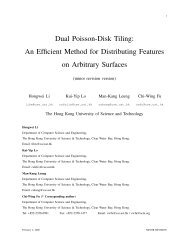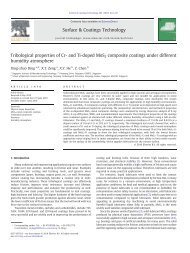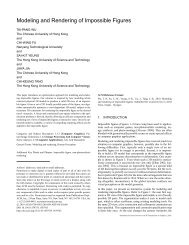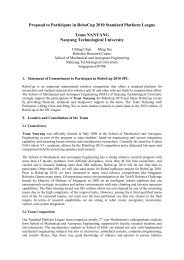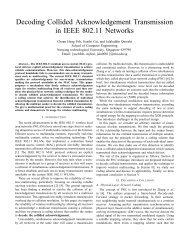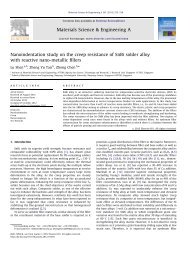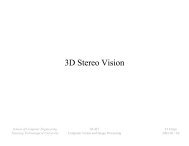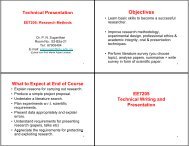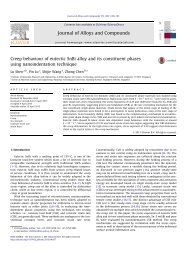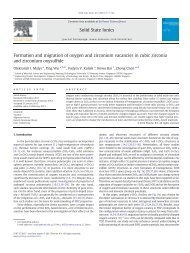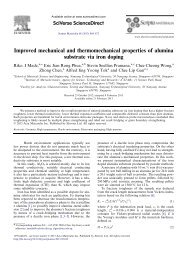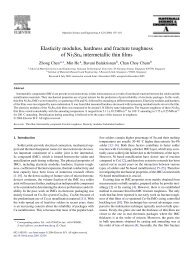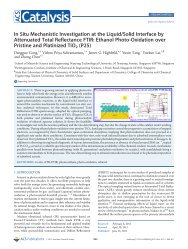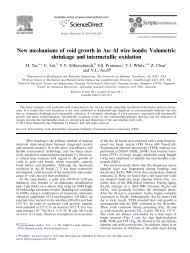Growth of Intermetallic Compounds in Thermosonic Copper Wire ...
Growth of Intermetallic Compounds in Thermosonic Copper Wire ...
Growth of Intermetallic Compounds in Thermosonic Copper Wire ...
Create successful ePaper yourself
Turn your PDF publications into a flip-book with our unique Google optimized e-Paper software.
126<br />
Fig. 1. SEM image <strong>of</strong> typical copper wire ball bonds formed by<br />
thermosonic bond<strong>in</strong>g on alum<strong>in</strong>um metallization on an IC.<br />
approximately 1 nm diameter was used for composition<br />
analysis with EDX. TEM–SAD was performed<br />
to identify the type and structure <strong>of</strong> Cu-Al IMCs.<br />
RESULTS AND DISCUSSION<br />
Interfacial Morphology <strong>of</strong> Cu-Al Bonds<br />
<strong>in</strong> As-Bonded State<br />
Cu-Al bonds need to withstand thermal and<br />
electrical impacts dur<strong>in</strong>g device operation, especially<br />
at the <strong>in</strong>terface; their <strong>in</strong>itial states and morphology<br />
are the key factors for their reliability. 1<br />
Figure 1 shows typical copper-wire ball bonds on<br />
alum<strong>in</strong>um metallization obta<strong>in</strong>ed by means <strong>of</strong><br />
thermosonic bond<strong>in</strong>g with optimized parameters<br />
(Table I). The failure <strong>in</strong> the shear test typically<br />
occurs <strong>in</strong> the mashed copper ball rather than at the<br />
<strong>in</strong>terface between the ball and the alum<strong>in</strong>um metallization<br />
pad (Fig. 2); <strong>in</strong> the pull test it typically<br />
occurs as a neck break (Fig. 3), <strong>in</strong>dicat<strong>in</strong>g that the<br />
Cu-Al bond has high strength.<br />
In order to ascerta<strong>in</strong> the <strong>in</strong>terfacial characteristics<br />
<strong>of</strong> Cu-Al bonds <strong>in</strong> the as-bonded state, SEM and<br />
TEM were employed. A cross-sectional SEM image<br />
(Fig. 4) shows no visible IMCs at the <strong>in</strong>terface at<br />
such magnification. However, at higher resolution,<br />
the bright-field (BF) TEM image (Fig. 5) shows<br />
IMCs particles formed between alum<strong>in</strong>um and<br />
copper. Those discont<strong>in</strong>uous IMC particles are<br />
approximately 30 nm thick. Based on our previous<br />
work, this very <strong>in</strong>itial phase is CuAl2. 20<br />
Previous studies <strong>of</strong> Au-Al bonds based on SEM<br />
and TEM observations revealed a 200-nm- to<br />
500-nm-thick Au-Al IMC layer formed at the<br />
<strong>in</strong>terface dur<strong>in</strong>g the thermosonic bond<strong>in</strong>g stage<br />
(175°C), 10,11 although the mechanism <strong>of</strong> formation<br />
<strong>of</strong> Au-Al IMCs with<strong>in</strong> several milliseconds<br />
rema<strong>in</strong>s unclear. As for Cu-Al bonds, the above<br />
morphological analysis showed only approximately<br />
30-nm-thick and discont<strong>in</strong>uous Cu-Al IMCs at the<br />
Xu, Liu, Silberschmidt, and Chen<br />
Fig. 2. Failure <strong>in</strong> mashed copper balls after shear test show<strong>in</strong>g high<br />
strength <strong>of</strong> Cu-Al bonds (average shear force 145 gf).<br />
Fig. 3. Failure <strong>in</strong> necks after pull test, confirm<strong>in</strong>g good bondability<br />
(average pull force 41 gf).<br />
Fig. 4. Cross-sectional SEM image <strong>of</strong> Cu/Al <strong>in</strong>terface <strong>in</strong> the asbonded<br />
state.<br />
<strong>in</strong>terface. No voids were observed near the Cu-Al<br />
<strong>in</strong>terface; as reported, some nanolevel voids were<br />
found <strong>in</strong>side the Au-Al IMCs for the Au-Al system. 11



